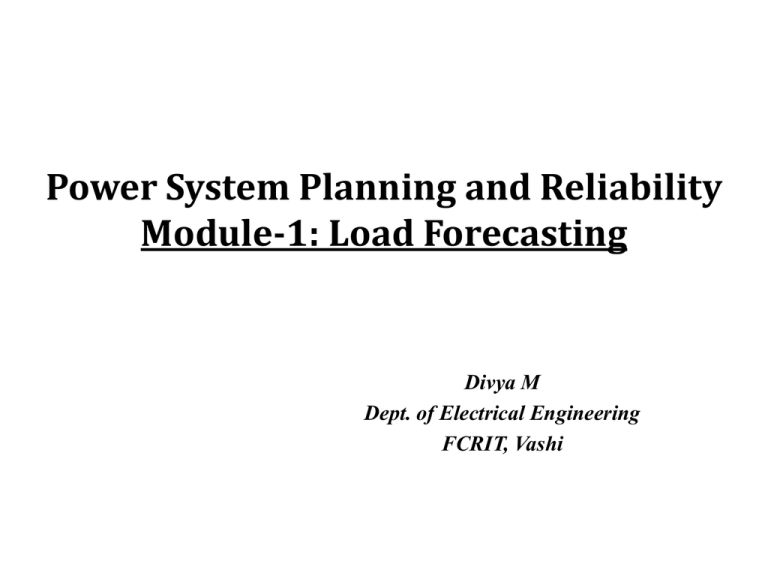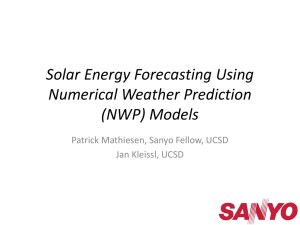loadforecasting-130201115659
advertisement

Power System Planning and Reliability Module-1: Load Forecasting Divya M Dept. of Electrical Engineering FCRIT, Vashi Power system planning Definition A process in which the aim is to decide on new as well as upgrading existing system elements, to adequately satisfy the loads for a foreseen future Elements can be: • • • • • PSPR Generation facilities Substations Transmission lines and/or cables Capacitors/Reactors Etc. Lecture-1 (Seifi & Sepasian) Power system planning Decision should be • Where to allocate the element (for instance, the sending and receiving end of a line), • When to install the element (for instance, 2020), • What to select, in terms of the element specifications (for instance, number of bundles and conductor type). The loads should be adequately satisfied. PSPR Lecture-1 (Seifi & Sepasian) Load forecasting The first crucial step for any planning study Forecasting refers to the prediction of the load behaviour for the future Words such as, demand and consumption are also used instead of electric load Energy (MWh, kWh) and power (MW,kW) are the two basic parameters of a load. By load, we mean the power. Demand forecast • To determine capacity of generation, transmission and distribution required Energy forecast • To determine the type of generation facilities required PSPR Lecture-1 (Seifi & Sepasian) Load curves Variations in load on a power station from time to time • Daily load curves • Monthly load curves • Annual load curves Load curve gives: • • • • • PSPR Variation of load during different time Total no. of units generated Maximum demand Average load on a power station Load factor Lecture-1 (Pabla) Daily load curve - example PSPR Lecture-1 www.nationalgrid.com Nature of loads Load characteristics: Demand factor Load factor Diversity factor Utilization factor Power factor Demand factor Max . demand Connected Load factor load Avg . demand Max . demand Diversity factor Sum of individual max . demands Max . demand of power station Utilisatio n factor Max . demand on power station Rated capacity of power station • Higher the values of load factor and diversity factor, lower will be the overall cost per unit generated. • Higher the diversity factor of the loads, the fixed charges due to capital investment will be reduced. PSPR Lecture-1 (Pabla) Types of loads Five broad categories: Domestic • Demand factor: 70-100% • Diversity factor: 1.2-1.3 • Load factor: 10-15% Commercial • Demand factor: 90-100% • Diversity factor: 1.1-1.2 • Load factor: 25-30% Industrial • Small-scale: 0-20 kW • Medium-scale: 20-100 kW • Large-scale: 100 kW and above – Demand factor: 70-80% – Load factor: 60-65% PSPR Lecture-1 (Pabla) Types of loads Agricultural • Demand factor: 90-100% • Diversity factor: 1-1.5 • Load factor: 15-25% Other loads • Street lights, bulk supplies, traction etc. Commercial and agricultural loads are characterized by seasonal variations. Industrial loads are base loads and are little weather dependent. PSPR Lecture-1 (Pabla) Numerical A power plant supplies the following loads with maximum demand as below: Type of load Max. demand (MW) Industries 100 Domestic 15 Commercial 12 Agriculture 20 The maximum demand on the power station is 110 MW. The total units generated in the year is 350 GWh. Calculate: • Yearly load factor • Diversity factor PSPR Lecture-1 (Pabla) Electrical load growth Reasons for the growth of peak demand and energy usage within an electric utility system: • New customer additions – Load will increase if more customers are buying the utility's product. – New construction and a net population in-migration to the area will add new customers and increase peak load. • New uses of electricity – Existing customers may add new appliances (replacing gas heaters with electric) or replace existing equipment with improved devices that require more power. – With every customer buying more electricity, the peak load and annual energy sales will most likely increase. PSPR Lecture-2 (Willis) Planning and electrical load growth Load growth caused by new customers who are locating in previously vacant areas. • Such growth leads to new construction and hence draws the planner's attention. Changes in usage among existing customers • Increase in per capita consumption is spread widely over areas with existing facilities already in place, and the growth rate is slow. • Difficult type of growth to accommodate, because the planner has facilities in place that must be rearranged, reinforced, and upgraded. This presents a very difficult planning problem. PSPR Lecture-2 (Willis) Factors affecting load forecasting Time factors such as: • Hours of the day (day/night) PSPR • Day of the week (week day/weekend) • Time of the year (season) Weather conditions (temperature and humidity) Class of customers (residential, commercial, industrial, agricultural, public, etc.) Special events (TV programmes, public holidays, etc.) Population Economic indicators (per capita income, Gross National Product (GNP), Gross Domestic Product (GDP), etc.) Trends in using new technologies Electricity price Lecture-2 (Pabla) Forecasting methodology Forecasting: systematic procedure for quantitatively defining future loads. Classification depending on the time period: • Short term • Intermediate • Long term Forecast will imply an intermediate-range forecast • Planning for the addition of new generation, transmission and distribution facilities must begin 4-10 years in advance of the actual inservice date. PSPR Lecture-2 (Sullivan) Forecasting techniques Three broad categories based on: • Extrapolation – Time series method – Use historical data as the basis of estimating future outcomes. • Correlation – Econometric forecasting method – identify the underlying factors that might influence the variable that is being forecast. • Combination of both PSPR Lecture-2 (Sullivan) Extrapolation Based on curve fitting to previous data available. With the trend curve obtained from curve fitted load can be forecasted at any future point. Simple method and reliable in some cases. Deterministic extrapolation: • Errors in data available and errors in curve fitting are not accounted. Probabilistic extrapolation • Accuracy of the forecast available is tested using statistical measures such as mean and variance. PSPR Lecture-2 (Sullivan) Extrapolation Standard analytical functions used in trend curve fitting are: • Straight line: • Parabola: • s curve: y a bx y a bx cx 2 y a bx cx dx 2 • Exponential: • Gompertz: y ce y ln 1 3 dx ( a ce dx ) Best trend curve is obtained using regression analysis. Best estimate may be obtained using equation of the best trend curve. PSPR Lecture-2 (Sullivan) Correlation Relates system loads to various demographic and economic factors. Knowledge about the interrelationship between nature of load growth and other measurable factors. Forecasting demographic and economic factors is a difficult task. No forecasting method is effective in all situations. Designer must have good judgment and experience to make a forecasting method effective. PSPR Lecture-2 (Sullivan) Impact of weather in load forecasting Weather causes variations in domestic load, public lighting, commercial loads etc. Main weather variables that affect the power consumption are: • • • • Temperature Cloud cover Visibility precipitation First two factors affect the heating/cooling loads Others affect lighting loads PSPR Lecture-2 (Pabla) Impact of weather in load forecasting Average temperature is the most significant weather dependent factor that influences load variations. Temperature and load are not linearly related. Non-linearity is further complicated by the influence of • Humidity • Extended periods of extreme heat or cold spells In load forecast models proper temperature ranges and representative average temperatures which cover all regions of the area served by the electric utility should be selected. PSPR Lecture-2 (Pabla) Impact of weather in load forecasting Cloud cover is measured in terms of: • • • • height of cloud cover Thickness Cloud amount Time of occurrence and duration before crossing over a population area. Visibility measurements are made in terms of meters/kilometers with fog indication. To determine impact of weather variables on load demand, it is essential to analyze data concerning different weather variables through the cross-section of area served by utility and calculate weighted averages for incorporation in the modeling. PSPR Lecture-2 (Pabla) Energy forecasting To arrive at a total energy forecast, the forecasts for residential, commercial and industrial customers are forecasted separately and then combined. PSPR Lecture-3 (Sullivan) Residential sales forecast Population method • Residential energy requirements are dependent on: – Residential customers – Population per customer – Per capita energy consumption • To forecast these factors: – Simple curve fitting – Regression analysis • Multiplying the three factors gives the forecast of residential sales. PSPR Lecture-3 (Sullivan) Residential sales forecast Synthetic method • Detailed look at each customer • Major factors are: – Saturation level of major appliances – Average energy consumption per appliance – Residential customers • Forecast these factors using extrapolation. • Multiplying the three factors gives the forecast of residential sales. PSPR Lecture-3 (Sullivan) Commercial sales forecast Commercial establishments are service oriented. Growth patterns are related closely to growth patterns in residential sales. Method 1: • Extrapolate historical commercial sales which is frequently available. Method 2: • Extrapolate the ratio of commercial to residential sales into the future. • Multiply this forecast by residential sales forecast. PSPR Lecture-3 (Sullivan) Industrial sales forecast Industrial sales are very closely tied to the overall economy. Economy is unpredictable over selected periods Method 1: • Multiply forecasted production levels by forecasted energy consumption per unit of production. Method 2: • Multiply forecasted number of industrial workers by forecasted energy consumption per worker. PSPR Lecture-3 (Sullivan) Peak load forecasting Extrapolate historical demand data • Weather conditions can be included Basic approach for weekly peak demand forecast is: 1. 2. 3. 4. 5. 6. PSPR Determine seasonal weather load model. Separate historical weather-sensitive and non-weather sensitive components of weekly peak demand using weather load model. Forecast mean and variance of non-weather-sensitive component of demand. Extrapolate weather load model and forecast mean and variance of weather sensitive component. Determine mean, variance and density function of total weekly forecast. Calculate density function of monthly/annual forecast. Lecture-3 (Sullivan) Peak load forecasting Assume that the seasonal variations of the peak demand are primarily due to weather. Otherwise, before step-3 can be undertaken, any additional seasonal variation remaining after weather-sensitive variations must be removed To use the proposed forecasting method, a data base of at least 12 years is recommended. To develop weather load models daily peaks and coincident weather variable values are needed. PSPR Lecture-3 (Sullivan) Weather load model Plot a scatter diagram of daily peaks versus an appropriate weather variables. • Dry-bulb temperature and humidity • Using curve fitting three line segments can be defined in the example w k s (T T s ) if T T s k w (T T w ) if T T w 0 if T w T T s Parameters of the model: • Slopes: ks and kw • Threshold temperatures: Ts and Tw PSPR Lecture-3 (Sullivan) Separating weather-sensitive and nonweather sensitive components From the weather load model • Weather-sensitive (WS) component of weekly peak load demand data is calculated from the weekly peak coincident dry-bulb temperatures. • Non-weather-sensitive (NWS) component of peak demand is obtained by subtracting the first component from historical data. • NWS component is used in step-3, of basic approach for weekly peak demand forecast , to forecast the mean and variance of the NWS component of future weekly peak demands. PSPR Lecture-3 (Sullivan) Reactive load forecasting PSPR Lecture-4 (Pabla) Total forecast PSPR Lecture-4 (Sullivan) Annual peak demand forecast PSPR Lecture-4 (Sullivan) Monthly peak demand forecast PSPR Lecture-4 (Sullivan) References “Electric Power System Planning: Issues, Algorithms and Solutions”, Hossein Seifi and Mohammad Sadegh Sepasian, Springer-Verlag Berlin Heidelberg, 2011. “Electrical Power Systems Planning”, A.S. Pabla, Macmillan India Ltd., 1988. “Power System Planning”, R.L. Sullivan, McGraw-Hill International “Power Distribution Planning Reference Book”, H. Lee Willis, Marcel Dekker Inc. Weather sensitive load w k w (T T w ) kW kS w k s (T T s ) D0 TW TS Temperature









